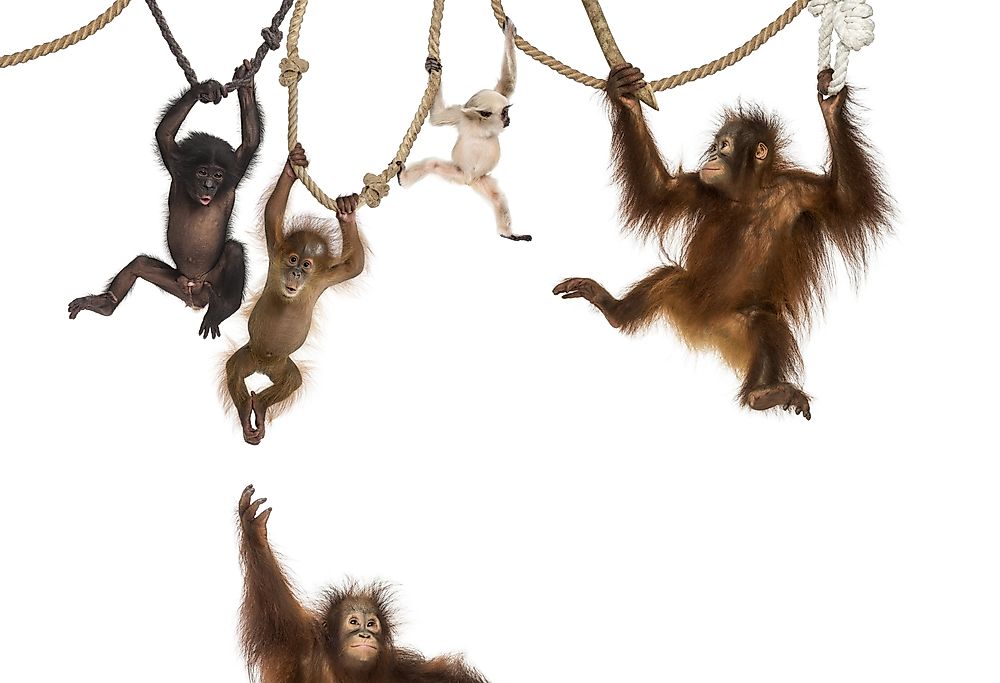List of Primates by Population

A "primate" refers to any member of the biological order Primates and contains species that are commonly related such as monkeys, lemurs, bush babies and apes. Humans belong to the category of apes. Primates are found in all continents around the world, with non-human primates mostly occurring in Africa, Central and South America and southern Asia. The order of primates is divided into three main groups namely: prosimians, monkeys of the New World, and monkeys and apes of the Old World. The distinguishing characteristic of primates includes five fingers (pentadactyly), a dental pattern and an unspecialized body plan. Additionally, most primates have fingernails and opposing thumbs. Old World monkeys and New World monkeys live in tropical forest environments of Asia, Africa, and the Americas. Primates are social animals who live in bands and small groups. Some of the largest primates include gorillas, orangutans, baboons, and chimpanzees.
The Most Populous Primates Of The World
As per the best estimates, these are some of the most populous primates on Earth.
Humans
Humans are the most populous primates on earth with a population of about 7.5 billion people. The modern human, Homo sapiens, is the only extant member of Hominina tribe (human tribe) and belongs to the family of great apes. Humans have larger and more complex brains compared with other apes. The success of the modern human species is attributed to the large and complex brain and the development of special cognitive abilities which enable the human to reason, use language, solve problems and live in social and cultural units. Our existence as humans has been sustained through hunting and gathering in ancient band societies. Today, humans are the most dominant of species on earth and the most influential, affecting greatly the habitats and environments of other species.
Muller's Bornean Gibbon
The Muller's Bornean Gibbon are the second most populous primate species on earth. They live in the evergreen tropical forest and mainly found in Borneo. They are native to Indonesia and Malaysia. Over the last 45 years, the Bornean gibbon has witnessed a 50% reduction in population due to deforestation, hunting, and poaching. They thrive well in evergreen forests where they can be found in large numbers.
Geladas
Also known as the bleeding-heart monkey, they belong to the old world monkey group and are found in the highlands of Ethiopia, where they occur in large populations around the Semien mountains. Geladas are the most terrestrial primates in the world (aside from humans). They are mostly grass-eaters and represent the once numerous species of grass-eater primates. They stay in high altitude regions of the mountain. As a result, they have developed short stumpy fingers which make them adept rock climbers.
Common Chimpanzee
The Common chimpanzee is also known as the robust chimpanzee and is a species of the great ape. It is characterized by coarse black hair, bare face, fingers, and feet. They live in groups of 15-150 individuals. They use tools such as modifying sticks and rocks to forage and hunt for food. Today, their population is estimated to be between 172,700 - 299,700 individuals. They face threats due to habitat loss, poaching, and disease.
Western Gorilla
Gorillas are the largest of the living apes and primates. They are mainly found in the subtropical forests of central Africa. There are three main groupings of gorillas; eastern, western and mountain gorillas of Africa. The western gorilla is smaller in size and lighter than their eastern relative. Mature males are known as silverbacks due to the silvery-white hair on their back. They live in sociable groups led by a dominant male and several females and their offspring. The male weighs up to 140kg while the female weighs 70kg.
Conservation Of Non-human Primates
More than a third of all primates are critically endangered or vulnerable according to The International Union for Conservation of Nature (IUCN) listing. About 75% of all primates have a declining population with 60% of the primate species facing extinction. Most of the critically endangered primates are in Madagascar and southern Asia. The common threats to all primate species include habitat loss, poaching, forest defragmentation and monkey drives. With most primates being affected due to the large-scale clearing of the tropical forest by humans to accommodate agriculture and settlement.
List of Primates by Population
| Rank | Primate Name | Population (Est.) |
|---|---|---|
| 1 | Human | 7,500,000,00 |
| 2 | Muller's Bornean Gibbon | 250,000 - 375,000 |
| 3 | Gelada | 200,000 |
| 4 | Common Chimpanzee | 172,700 - 299,700 |
| 5 | Western Gorilla | 150,000-200,000 |
| 6 | Bornean Orangutan | 45,000-69,000 |
| 7 | Mentawai Langur | 36,000 |
| 8 | Bonobo | 29,500-50,000 |
| 9 | Kloss's Gibbon | 20,000-50,000 |
| 10 | Red-eared Guenon | 20,000 |
| 11 | Nilgiri Langur | 20,000 |
| 12 | Siberut macaque | 17,000-30,000 |
| 13 | Northern red colobus | 15,400 |
| 14 | Barbary macaque | 15,000 |
| 15 | Roosmalens' Dwarf Marmoset | 10,000 |
| 16 | Natuna Island Surili | 10,000 |
| 17 | Madame Berthe's Mouse Lemur | 8,000 |
| 18 | Sumatran Orangutan | 7,300 |
| 19 | Gray-headed Lemur | 7,265 |
| 20 | Pig-tailed lemur | 6,700-17,300 |
| 21 | Golden-headed Lion Tamarin | 6,000-15,000 |
| 22 | Golden-crowned sifaka | 6,000-10,000 |
| 23 | Cottontop Tamarin | 6,000 |
| 24 | Golden bamboo lemur | 5,916 |
| 25 | Eastern gorilla | 5,880 |











